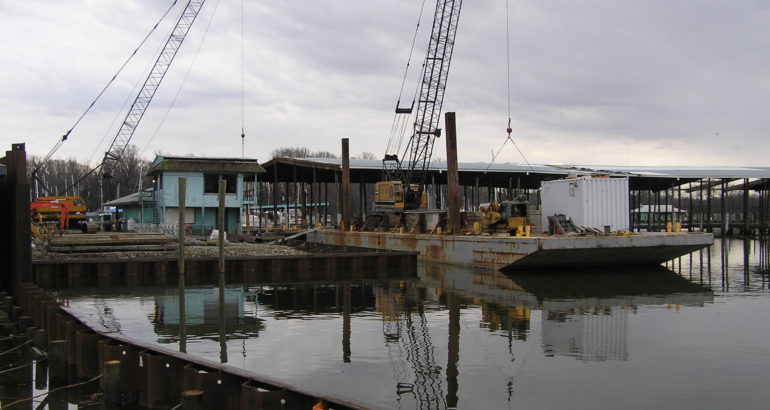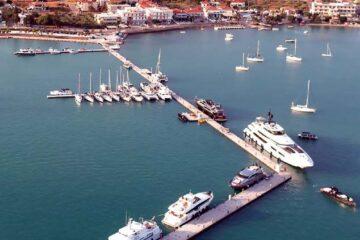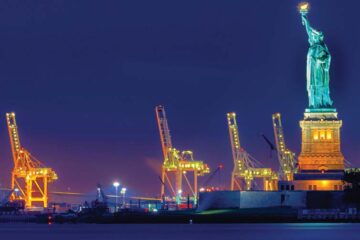FIXED AND FLOATING BERTHING STRUCTURES
Selecting a Fixed or Floating Berthing Structure –
The selection of a fixed or floating Marine Berthing Structure is of primary concern to the construction of any marina project. While generally it is primarily determined by the water level fluctuation at the site, there are many parameters that determine the selection process as well. The requirement that the fixed pier or float deck elevation match as closely as practical the deck freeboard of vessels that use the pier or float, both to facilitate boarding and to reduce the need for mooring line adjustment is extremely important, there is more. This article is merely a brief synopsis of some of the guidelines one might use when reviewing the selection of such a fixed or floating dock or marina structure.
Another important consideration is wave height at exposed berths; where waves greater than 2 feet can occur and problems due to floating dock motions would over-ride the benefits provided by the floating dock, a fixed system is preferred.
At sites where a fixed pier exists and the water level fluctuation and wave height criteria for a floating system are met, a floating dock with a variable slope gangway to transition from the pier to the float should be provided.
Fixed Systems –
Fixed systems are generally selected where the tidal range for coastal sites or the seasonal water level range for inland rivers or lakes is less than 3 feet (0.91m).
Floating Systems –
Floating systems are generally preferred where the tidal range or seasonal water level range is 3 feet (0.91m) or more.
Selecting Covered or Uncovered Berths –
Berthing systems are generally uncovered unless adverse weather, in particular precipitation, can be shown to interfere with boat operations, including boarding or essential dockside maintenance. Generally, covers to protect vessels from exposure to the elements and retard weathering (though common in recreational marinas) are not provided.
Covers for berthing systems are supported on the fixed piers. Covers for floating berthing systems may be supported on the floating dock where wave conditions permit or on fixed pile supports. Berth covers contribute significant additional dead and live loads on the fixed pier or floating dock. Besides the additional dead weight, winds can produce substantial lateral and uplift forces on the dock structure.
Fixed piers or floating docks should not be retrofitted with covers unless the structure (including flotation) was designed for the additional loads produced by the covers, or the berthing structure itself is retrofitted to withstand the additional loads.
BERTHING SYSTEM LOADING CRITERIA
Dead Loads –
The dead load should include the self-weight of the structure and all permanent attachments such as cleats, fenders, dock boxes, utility pedestals with associated electrical and water lines, fire suppression standpipes and fire lines, light stanchions, power centers, and where fitted, storage lockers, fuel dispensers and fuel lines, sewage pump out units and sewage lines, etc. The water, fire, fuel and sewage lines should be considered full of liquid. If the berths will be covered, include the superimposed dead load of the cover structure.
The dead load for floating docks should also include the weight of pile guides or anchoring hardware, the superimposed dead load of the gangway reaction on the dock, and an allowance for weight gain due to water absorption in the dock flotation.
Vertical Live Loads –
The vertical live load may be uniformly distributed or a concentrated point load; both cases should be checked to identify the governing case for design. The restricted access pedestrian application may be used when dock access is controlled and the number of persons on the pier or dock at any one time can be limited to typical recreational marina densities. When it is possible for a large number of persons to congregate on the pier or dock, the unrestricted access pedestrian application should be used. In the case of floating docks, this will impose substantial additional demand on the dock to satisfy freeboard and stability criteria.
Freeboard –
Floating docks under dead load should only have a minimum freeboard to the deck of 16 inches (40 cm) and a maximum of 24 (60 cm) inches.For a safe and visually pleasing dock system, the deck cross slope on walkways or fingers should not exceed 2% and the freeboard overall should not depart from the average by more than 1 inch (2.5 cm). Under full live load plus dead load, floating docks should have a minimum freeboard of 10 in (25 cm).
In the event that a uniform live load of 100 psf (20 kPa) is required, additional dead load freeboard of at least 15 in (38 cm) would be needed to meet the fully loaded minimum freeboard of 10 in (25 cm). As a result, the dock may ride too high under dead load only to satisfy functional requirements. If this occurs, consideration may be given to reducing the fully loaded minimum freeboard if the fully loaded condition is a rare occurrence, provided that the stability requirements can still be satisfied.
The dock freeboard and stiffness requirements (to limit deck slopes) may control the structural and flotation design rather than the minimum live loads, and should be checked.
Stability –
The dock should have a minimum freeboard of 2 in (5.1 cm) to the top of the buoyancy pontoon to provide reserve buoyancy under full live load plus dead load. If the buoyancy pontoons provide full flotation to the top of the deck, the minimum dock freeboard noted above is sufficient to satisfy this requirement. If the width of the pontoon varies (pipe pontoons for instance) with submergence, then the minimum freeboard of the pontoon should be increased to provide reserve buoyancy equivalent to the 2 inch (5.1 cm) requirement.
The dock should also be able to withstand overturning forces and return to a normal freeboard and level condition upon removal of any unbalanced forces. Floating dock systems that consist of interconnected walkway and finger docks will generally satisfy this requirement. However, long and narrow dock modules may not, in which case a metacentric method calculation of stability should be performed. A floating dock is stable if under all conditions of loading, the metacenter is located a safe distance above the center of gravity of the structure.









